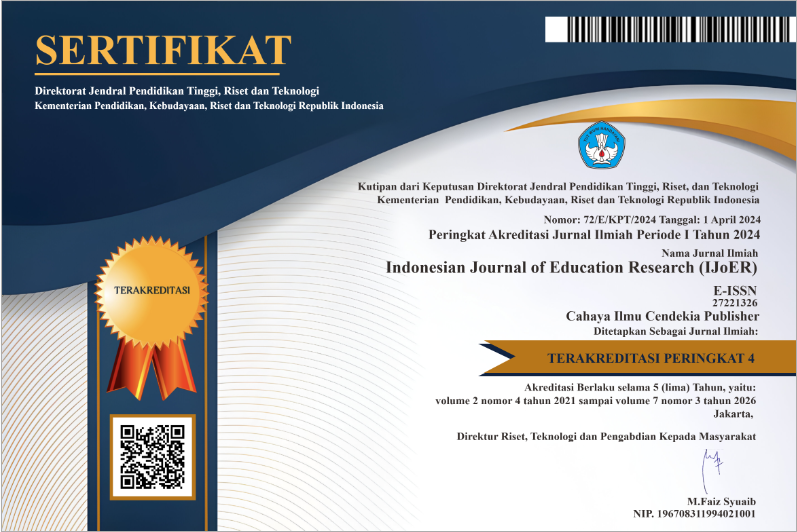The Effect of Learning Interest and Learning Environment on Student Learning Outcomes in History Class X IPS
Abstract
Purpose of the study: To determine the effect of interest and the learning environment on student learning outcomes in sijarah subject class X IPS SMA N 1 Sungai Penuh.
Methodology: This research includes quantitative research with descriptive methods. sampling using saturated sample technique. Data on interest in learning and the learning environment were collected through questionnaires, while data on student learning outcomes was obtained through documentation, namely odd semester exam scores. Data analysis techniques in this study used descriptive analysis techniques and regression analysis.
Main Findings: There is a joint effect of interest in learning and the learning environment on student learning outcomes in class X IPS at SMA Negeri 1 Sungai Full with the coefficient of regression field equation variable interest in learning 0.671 and learning environment variable 0.420.
Novelty/Originality of this study: This study discusses 2 variables in determining learning outcomes, namely using interest and learning environment variables.
References
C. C. Brandenberger, G. Hagenauer, and T. Hascher, “Promoting students ’ self-determined motivation in maths : results of a 1-year classroom intervention,” Eur J Psychol Educ, 2017, doi: 10.1007/s10212-017-0336-y.
D. Hickmott, E. Prieto-Rodrigue, and K. Holmes, “A Scoping Review of Studies on Computational Thinking in K – 12 Mathematics Classrooms,” Digit Exp Math Educ, vol. 4, no. 1, pp. 48–69, 2018.
J. E. Smith, “Creative Self-Efficacy: An Essential Transition Skill for Students With Learning Disabilities,” Interv. Sch. Clin., vol. 57, no. 4, pp. 256–261, 2022, doi: 10.1177/10534512211024938.
Y. Yang, Y. Zhang, X. Xiong, W. Zhang, W. Chen, and S. Ge, “From Lab Scale to Mass Production: A Project-Based Learning on the Preparation of (S)-Epichlorohydrin for Enhancing College Student Engineering Practical Abilities,” J. Chem. Educ., vol. 98, no. 12, 2021, doi: https://doi.org/10.1021/acs.jchemed.1c00483.
S. Fauziyah and M. B. Triyono, “Pengaruh E-Learning Edmodo Dengan Model Blended Learning Terhadap Minat Belajar,” J. Kependidikan Penelit. Inov. Pembelajaran, vol. 4, no. 1, pp. 112–124, 2020, doi: 10.21831/jk.v4i1.27562.
K. Kamid, K. Anwar, D. Iriani, and A. M. Nawahdani, “Analysis of interest and process skills in learning mathematics,” J. Ris. Pendidik. Mat., vol. 8, no. 2, pp. 244–258, 2021, doi: 10.21831/jrpm.v8i2.42640.
I. Mudasih and W. T. Subroto, “Comparison of Student Learning Outcomes Through Video Learning Media with Powerpoint,” Int. J. Educ. Res. Rev., pp. 183–189, 2019, doi: 10.24331/ijere.517997.
M. Kamaluddin, “Pengaruh Motivasi Belajar terhadap Prestasi Belajar Matematika dan Strategi untuk Meningkatnya,” Semin. Matermatika dan Pendidik. Mat., pp. 455–460, 2017.
Sugiyono, Metode Penelitian dan Pengembangan. Bandung: Alfabeta, 2015.
Sugiyono, Metode Penelitian Kuantitatif Kualitatif dan R & D. Bandung: Alfabeta, 2013.
Copyright (c) 2023 Linda Wati, Salsabila Afifah

This work is licensed under a Creative Commons Attribution-NonCommercial 4.0 International License.
Authors who publish with this journal agree to the following terms:
- Authors retain copyright and acknowledge that the Indonesian Journal of Education Research (IJoER) is the first publisher licensed under a Creative Commons Attribution 4.0 International License.
- Authors are able to enter into separate, additional contractual arrangements for the non-exclusive distribution of the journal's published version of the work (e.g., post it to an institutional repository or publish it in a book), with an acknowledgment of its initial publication in this journal.
- Authors are permitted and encouraged to post their work online (e.g., in institutional repositories or on their website) prior to and during the submission process, as it can lead to productive exchanges and earlier and greater citation of published work.






.png)
.png)




















